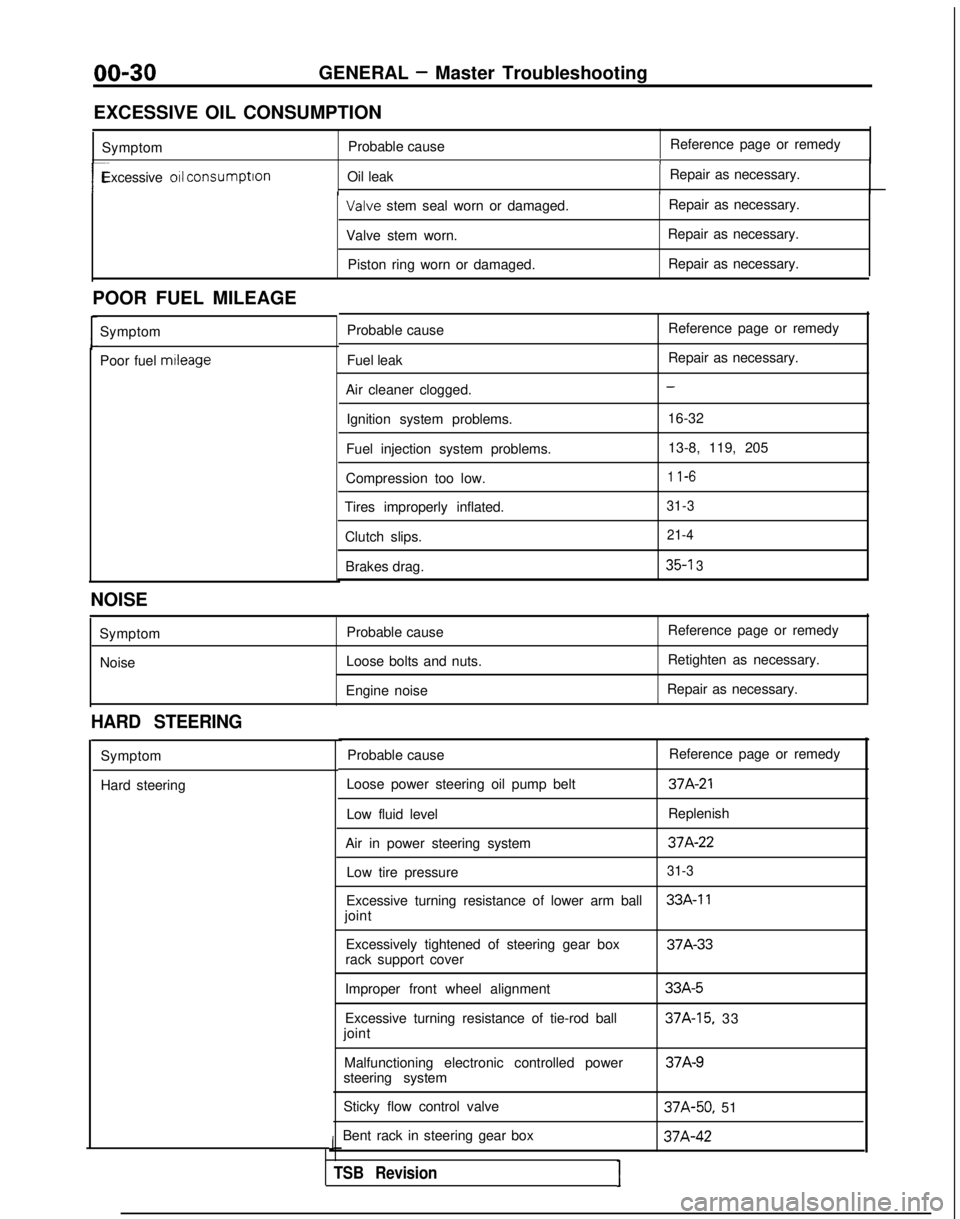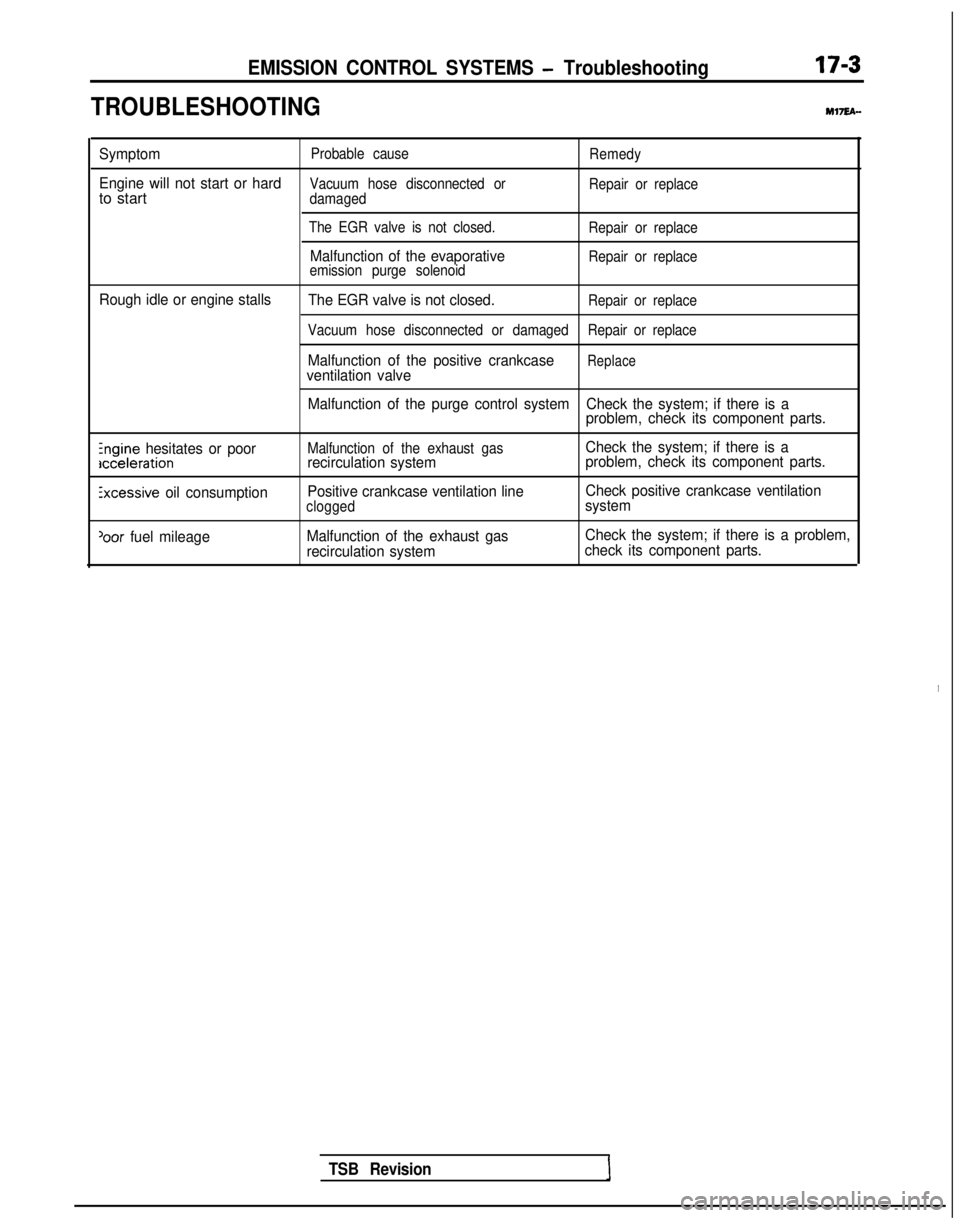Page 32 of 1273

00-30GENERAL - Master Troubleshooting
EXCESSIVE OIL CONSUMPTION Symptom Probable cause Reference page or remedy
1
r-Excessive 011 consumption
Oil leak Repair as necessary.I Valve
stem seal worn or damaged. Repair as necessary.
Valve stem worn. Repair as necessary.
Piston ring worn or damaged. Repair as necessary.
POOR FUEL MILEAGE Symptom
Poor fuel mtleage
Probable cause
Fuel leak
Air cleaner clogged. Ignition system problems.
Fuel injection system problems.
Compression too low.
Tires improperly inflated.
Clutch slips.Brakes drag. Reference page or remedy
Repair as necessary.
-
16-32
13-8, 119, 205
1 l-6
31-3 21-4
35-l 3
NOISE
SymptomNoise Probable cause
Loose bolts and nuts.
Engine noise Reference page or remedy
Retighten as necessary.
Repair as necessary.
HARD STEERING
Symptom
Hard steering Probable cause
Reference page or remedy
Loose power steering oil pump belt
37A-21
Low fluid level Replenish
Air in power steering system
37A-22
Low tire pressure31-3
Excessive turning resistance of lower arm ball33A-11
joint Excessively tightened of steering gear box 37A-33
rack support cover
Improper front wheel alignment
Excessive turning resistance of tie-rod ball
joint
Malfunctioning electronic controlled power
steering system
Sticky flow control valve
Bent rack in steering gear box
J
TSB RevisionI
33A-5
37A-15, 33 37A-9
37A-50,
51 37A-42
Page 37 of 1273

GENERAL -Lubrication and Maintenance/Recommended Lubricants and Lubricant Capacities Table00-35
If premium unleaded gasoltne IS not available,
MATERIALS ADDED TO FUEL
unleaded gasoline having a octane rating of 87 or
91 RON (Research Octane Number) may be used. Indiscriminate use of fuel system cleaning agents
In this case, the performance and fuel consumption should be avoided. Many of these materials
in-
WIII suffer a little degradatron.tended for gum and varnish removal may contain
highly active
solvents or similar ingredients that can
be harmful to gasket and diaphragm materials used
in fuel system component parts.
Gasolines containing alcohol
Some gasolrnes sold at service stations contain
alcohol, although they may not be SC identified. Use
of fuels containing alcohol is not recommended
unless the nature of the blend can be
determrned
as being satisfactory.
Gasohol
- A mixture of 10% ethanol (grain alcohol)
and 90% unleaded gasoline may be used
In your
car. If
driveability problems are experienced as a
result of using gasohol, it IS recommended that the
car be operated on gasoline. Methanol
- Do not use gasolines containing
methanol (wood alcohol). Use of this type of
alcohol can result in vehicle performance deteriora-
tion and damage critical parts in the fuel system
components. Fuel system damage and performance
problems, resulting from the use of gasolines
containing methanol, may not be covered by the
new car warranty.
Gasolines containing MTBE (Methyl Tertiary Butyl
Ether)
Unleaded gasolrne containrng
15% or less MTBE
may be used in your car. (Fuel containing MTBE
over 15% vol. may cause reduced engine per-
formance and produce vapor lock or hard starting.) RECOMMENDED
LUBRICANTS AND
LUBRICANT CAPACITIES TAB,&-
RECOMMENDED LUBRICANTS
Items
Engine Oil
Recommended lubricants
API classification SG or SGKD (For further details, refer to SAEviscosity number)
Manual Transaxle, Transfer
Rear Axle
API classification GL-4 or higher, SAE 75W-85W
Refer to P.OO-37.
Automatic Transaxle
Power Steering
Brake and Clutch
Engine Coolant DIAMOND ATF SP or equivalent
Automatic transmission fluid “DEXRON II” Conforming to
DOT3 or DOT4
DIA-QUEEN LONG-LIFE COOLANT (Part No. 0103044) or High
qualitv ethvlene-qlvcol
antifreeze coolant
Door HingesEngine oil
1 TSB Revision
Page 623 of 1273

EMISSION CONTROL SYSTEMS - Troubleshooting17-3
TROUBLESHOOTINGMVEA-
SymptomProbable causeRemedy
Engine will not start or hardVacuum hose disconnected or Repair or replaceto startdamaged
The EGR valve is not closed. Repair or replace
Malfunction of the evaporativeRepair or replace
emission purge solenoid
Rough idle or engine stalls The EGR valve is not closed.Repair or replace
Vacuum hose disconnected or damaged Repair or replace
Malfunction of the positive crankcaseReplaceventilation valve
Malfunction of the purge control system Check the system; if there is a
problem, check its component parts.
Engine hesitates or poorIcceleration
Zxcessive oil consumption
)oor fuel mileage
Malfunction of the exhaust gasrecirculation system
Positive crankcase ventilation line
clogged
Malfunction of the exhaust gas
recirculation system Check the system; if there is a
problem, check its component parts.
Check positive crankcase ventilation
system
Check the system; if there is a problem,
check its component parts.
TSB Revision
Page 743 of 1273

AUTOMATIC TRANSAXLE - Troubleshooting23-37
ELEMENT IN USE AT EACH POSITION OF SELECTOR LEVER
NOTECl. . . . . . . . .FrontclutchC2 . . . . . . . . .Rear clutchC3 . . . . . . . . .EndclutchOWC . . . . . . One-way clutchBl
. . . . . . Kickdown brake82 .._.. Low-reverse brake
SHIFT PATTERNS
Two
shift patterns
are pm-stored
in the
control
‘unit of
this transaxle.
One is the
power
pattern
(for more powerful
performance), and
the
other
is the
economy
pattern
(for
improved
fuel consumption
and quieter
operation).
(Refer to
the
diagram below.)
The
driver
can select
and switch to the
desired
pattern
by
using
the
power/economy
select
switch on the
center
console.
The solid lines
shown
in these
shift patterns
indicate
up-shifts,
and
the
broken lines indicate. down-shifts. The reason why there
is a difference
between
the
shift points for
up-shifts
and for
down-shifts is so that up-shifts
and down-shifts will not
occur frequently
when
driving
at
a speed in the
vicinity of the
shift
point.
When the
vehicle
is stopped,
there
is a shift to -2nd gear
in order
to
obtain
a suitable
“creeping”, but
when the accelerator
pedal is
then
depressed
the
vehicle
starts
off in 1st gear.
TSB Revision